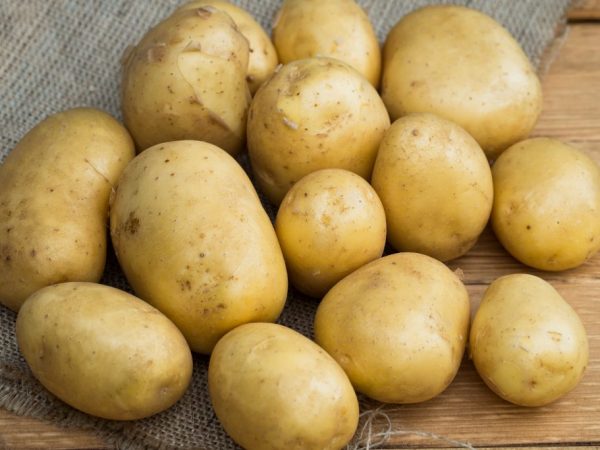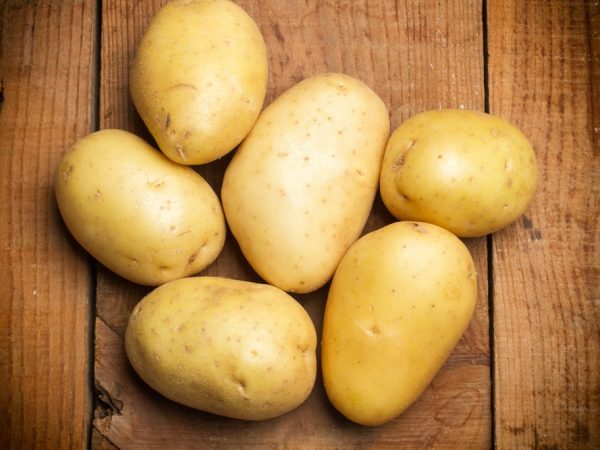Characteristics of the potato variety Golubizna
Potato Blueness is one of the mid-season varieties. It is intended for cultivation practically throughout the country, except perhaps in the regions of the Far North and Siberia, where the weather conditions are very harsh.

Characteristics of the potato variety Golubizna
Variety characteristic
The potato variety Golubizna is also called Goluboglazka for the color of the eyes.
From the time of planting seed tubers to the collection of products of technical ripeness, 3 months pass. During this period, the potatoes have time to fully ripen.
The yield is about 500 kg per 1 hundred square meters with the weight of one potato from 100 g to 150 g. The tubers contain at least 21% of starch and up to 26% of dry matter.
So that the variety does not degenerate over time, after 6 years the berries are harvested and the plant is propagated by seed. Blue potatoes are suitable for planting with both seeds and tubers, which must be selected in the fall.
Dignity
Blueness is a potato, the characteristic of which includes a number of positive qualities:
- drought and heat tolerance;
- tolerance to low temperatures;
- lack of tendency to degeneration and loss of species qualities;
- immunity to pests living in the soil;
- long growing season;
- yield.
According to the description, the blue potato has a strong immunity to viral diseases.
It is resistant to late blight in tops and fruits, to virus Y, common scab, and wilting and rolling of leaves. These features make it possible to use a small amount of antiviral drugs or completely eliminate them.
disadvantages
According to the characteristics, the Blueness variety is damaged by a golden cyst-forming nematode, it is necessary to process the soil from this pest before planting the tubers. For this, the drug "Nematorin" is introduced into the soil. This is the only disadvantage regarding this type of potato.
Description of the bush
The plant has upright bushes with a stem up to 60 cm high. They are ribbed and strong, do not break in strong winds. The green leaves are quite large and retain their color for more than 2 months. Flowers white with blue, collected in apical inflorescences. They are pollinated before they open up.
In dry summers, only partial leaf wilting is observed, while other varieties suffer greatly from high temperatures and lack of moisture.
The plant tolerates cold weather well. In this case, the leaves are not damaged, only they become more elastic.
Description of tubers

The fruits are versatile in use
The tubers are round, with blunt tops, covered with a thin yellow skin. The peel has a characteristic mesh pattern that can only be identified by touch. The pulp of the fruit is white.
Large starchy tubers are used in the industrial production of starch and dry potato semi-finished product. The tubers are also suitable for making chips and mashed potatoes. For home use, fruits of any size are suitable.Both salads and first courses, casseroles and pancakes, dumplings and zrazy are prepared from potatoes. All dishes have a beautiful view, excellent taste and pleasant aroma.
The marketable yield of tubers is influenced by their appearance. Marketability is 97% of the total harvest. This means that the tubers grow to almost the same size when grown.
During storage, all fruits remain fresh almost until the next harvest. At the same time, there is no wilting of tubers or flabbiness of the skin. Its color becomes more muted, not so bright.
In order to provide vegetables to regions of permafrost or alpine regions, it is necessary to deliver products to them. Not all varieties tolerate transportation as well as blue potatoes.
Preparing soil and tubers for planting
Plants are grown in a variety of soils, both clay and sandy. It is best if the soil is sandy loam, in which the root system can freely develop and give stolons. When forming tubers, it is necessary that they are not limited by compression, otherwise there will be no growth prospects.
In autumn, organic matter is introduced into the soil at the rate of 250 kg per 1 hundred square meters, 2 kg each of superphosphate, ammonium nitrate and potassium salt. The area is dug to a depth of 20 cm.
In the spring, the plot is leveled and the rows are marked, leaving about 60 cm between them. You can plant the tubers without marking, simply observing this distance visually. It is recommended to leave no more than 25 cm between the planting pits for this variety, so that the plantings are slightly thickened.
Choosing, the Blueness variety for seed potatoes, a month before planting, large fruits are cut lengthwise into 2 parts and laid out in boxes upside down for germination. The room temperature can be around 15 ° C or lower. When the sprouts reach a height of 3 cm, and the soil warms up to 7 ° C, the potatoes are planted.
At the bottom of the planting holes, 1 handful of ash and onion husks, 3 handfuls of compost are laid, sprinkled with soil 3 cm on top and the tubers are laid with sprouts up, then the holes are filled in and the surface of the soil is leveled.
Potato care
To grow a great crop, you need to take care of the plants:
- water the plantings at least 3 times;
- hilling bushes and fertilizing the soil;
- destroy weeds;
- fight pests.
Watering potato plantings significantly increases yields. Hilling prevents tubers from greening because they grow in the topsoil where the sun's rays can get in.
Fertilization of plants is combined with hilling in the rainy periods of summer. During dry months, it is best to fertilize the plantings while watering. Complex mineral fertilizers are prepared according to the recipes on the packages.
For organic feeding, fresh mullein or bird droppings are used. For 1 dose of organic matter, take 1 dose of water and set it for fermentation for a couple of weeks. The finished substance is diluted with water in a ratio of 1:10 and the beds are watered.
As the weeds grow, they are removed, and the soil is constantly loosened for better air access to the roots and tubers. Greens cut off with a hoe can be left if the weeds did not have time to set the seeds, so as not to sow the area with them again.
Pest drugs
For larvae of the Colorado potato beetle, aphids and cicadas, insecticides are used. Among the broad-spectrum drugs, you can choose pesticides, such as:
- Aktara;
- "Ratibor";
- "Antizhuk";
- Dantop.
The solutions are prepared independently, trying to adhere to the rules of personal hygiene and protecting themselves from contamination with poisons. For this, rubber gloves, face masks, aprons and goggles are used.
The effect of the drug primarily depends on the concentration. Do not exceed or cut the dosage of the substance, otherwise the result will be unpredictable, starting from the lack of effect and ending with the death of the plant.
Conclusion
Getting a big harvest depends entirely on the desire of the gardener to properly grow vegetables.Potatoes Blueness will thank the owner for their care with large and tasty fruits, and organic products help prepare healthy and vitamin dishes that will delight the whole family with a variety of tastes and aromas.

